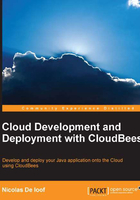
Cloud and clustering
Another consideration for a platform is clustering . Cloud is based on slicing resources into small virtual elements and letting the users select as many as they need. In most cases, this requires the application to support a clustering mode, as using more resources will require you to scale out on multiple hosts.
Clustering has never been a trivial thing, and many developers aren't familiar with the related constraints. The platform can help them by providing specialized services to distribute the load around the cluster's nodes. Some PaaS such as CloudBees or Google App Engine provide such features, while some don't. This is the major difference between PaaS offers. Some are IaaS-like preinstalled middleware services, while some offer a highly integrated platform.
A typical issue faced is that of state management. Java EE developers rely on HttpSession to store user's data and retrieve them on subsequent interaction. Modern frameworks tend to be stateless, but the state needs to be managed anyway. PaaS has to provide options to developers, so that they can choose the best strategy to match their own business requirements. This is a typical clustering issue that is well addressed by PaaS because the technical solutions (sticky session, session replication, distributed storage engines, and so on) have been implemented once with all the required skills to do it right, and can be used by all platform users.
Thanks to a PaaS, you don't need to be a clustering guru. This doesn't mean that it will magically let your legacy application scale out, but it gives you adequate tools to design the application for scalability.